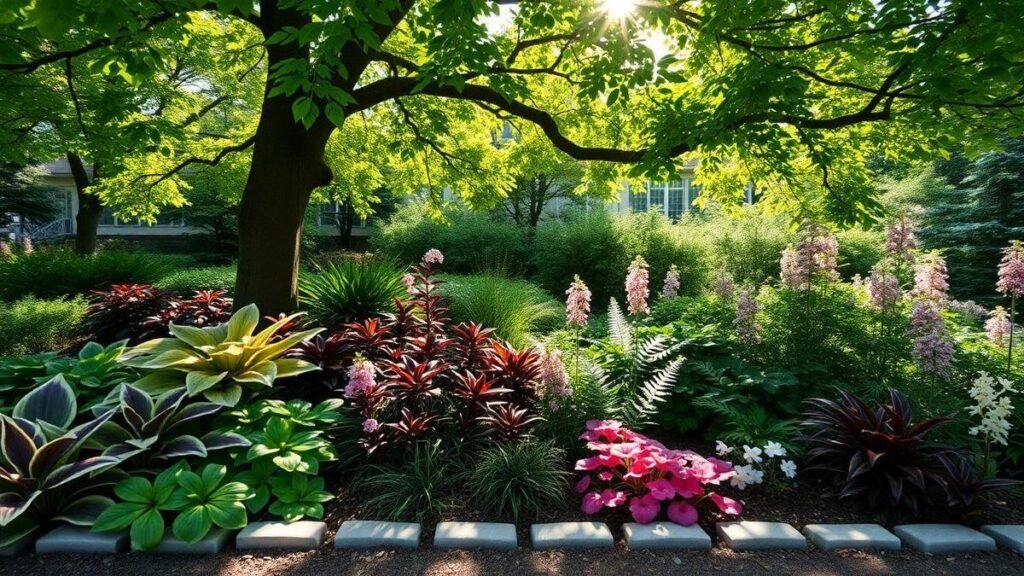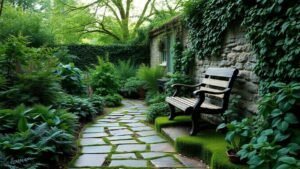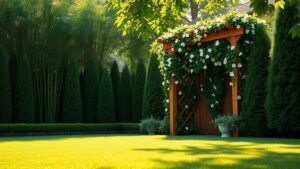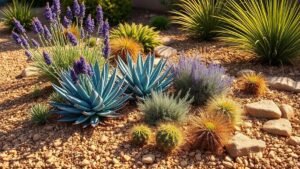Shade Tolerant Plants for colorful landscaping under trees
Shade Tolerant Plants for colorful landscaping under trees are my secret weapon for turning gloomy shade into a party of color. I pick them because they protect the soil amendments and structure, steady roots during seasonal changes, and keep my trees and the surrounding ecosystem happy while giving pops of colorful perennials all season. Below you’ll find light tips, go-to perennials like hostas, heuchera, and astilbe, trusty flowers such as hellebores and bleeding heart, fast groundcovers like ajuga and vinca minor, seasonal handoffs, lazy-gardener care hacks, and why I favor native plants for pollinators and better soil. Simple, practical, and a little silly—garden gorgeous shade without breaking a sweat.
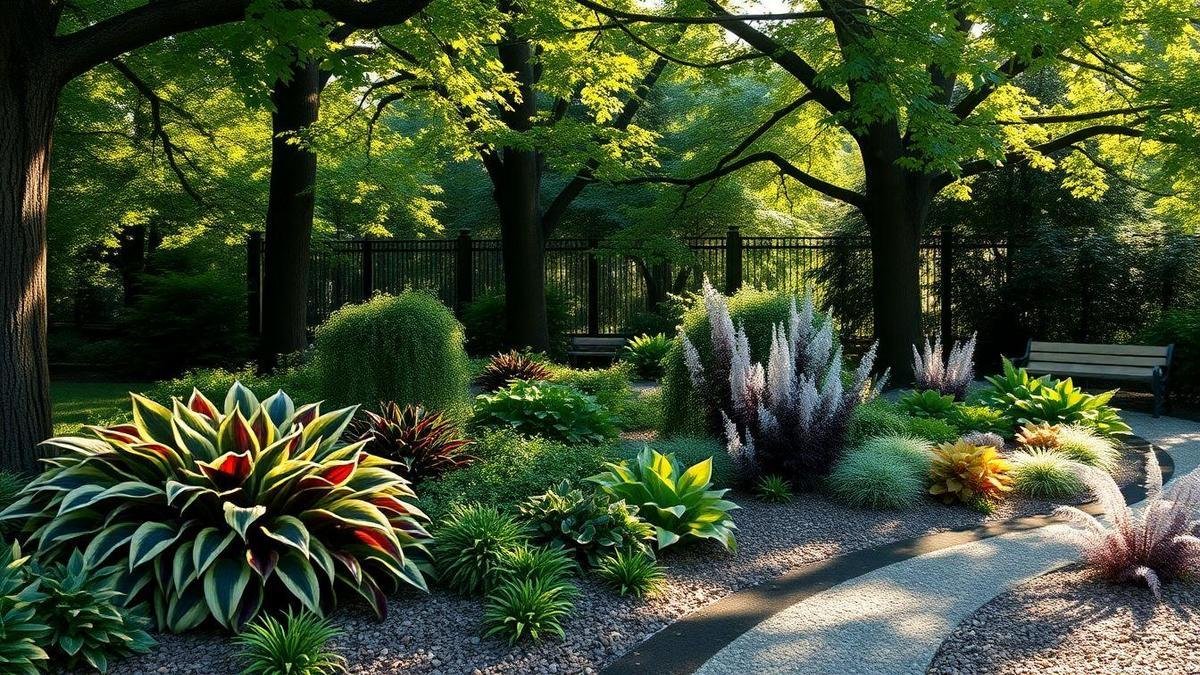
Key Takeaway
- I plant hostas, ferns, and shade flowers to add color under trees.
- I pick striped or spotted leaves to make dull shade look loud.
- I loosen soil with compost and amendments and add mulch so roots can breathe.
- I water less in shade so plants don’t drown in drama—see tips on preventing over- and underwatering.
- I avoid bossy spreaders so shy bloomers can shine.
Why I pick Shade Tolerant Plants for colorful landscaping under trees
I choose Shade Tolerant Plants for colorful landscaping under trees because they give color where grass fails. A tree canopy can be a feature, not a problem. These plants cover bare dirt, reduce maintenance, and make shady areas pop without hauling extra soil or water. For plant selection, I lean on resources about the best plants for low-light gardens and shade-loving perennials.
How shade-tolerant plants help soil, roots, and tree health
- They protect the top layer of soil, cutting erosion.
- Shallow, fibrous roots reduce competition with tree roots and lower compaction.
- Decaying leaves and spent blooms add organic matter, feeding soil life and the tree.
- A thin layer of mulch evens moisture and keeps weeds down—less work, healthier trees.
The colorful benefits I see from shade garden ideas under trees
I love the mix of color and texture: hostas for big leaves, heuchera for bright foliage, ferns for feathery green. Neighbors comment, pollinators visit, and the space looks finished from spring through winter with little fuss. If you want to boost pollinator activity beneath trees, I combine these with plants recommended for attracting visitors in pollinator-friendly beds.
Quick facts on light levels and choosing plants for shade under trees
| Light level | Hours of sun | Plant picks (short list) | Quick note |
|---|---|---|---|
| Dense shade | 0–2 hrs | Ferns, Hostas, Liriope | Best for deep green and texture |
| Dappled shade | 2–4 hrs | Heuchera, Astilbe, Pulmonaria | Spots of sun improve blooms |
| Light/Part shade | 4–6 hrs | Hydrangea, Bleeding heart, Impatiens | More bloom potential here |
Quick tips I use:
- Test light for a week before planting—watch when the sun hits the spot or consider using reflective surfaces to increase light in very dark corners.
- Match plants to the light. Don’t shove a sun-lover in a cave.
- Water new plants well the first year; after that, most shade perennials are low-fuss.

My Go-To Shade Tolerant Plants for colorful landscaping under trees (shade-loving perennials I trust)
Hostas, heuchera, and astilbe — colorful shade plants I plant most
I treat Hostas like an easy Sunday: big leaves, texture, low drama. Mix blue, green, and variegated types to avoid flat beds. For a broader list of similar picks, see my roundup of perennial plants for vibrant shady gardens.
Quick tips:
- Plant Hostas where roots get moisture.
- Use Heuchera at the front for bright foliage.
- Drop Astilbe into damp pockets for feathery plumes.
These three cover foliage, height, and season without hovering. They tolerate tree roots and hide bare spots.
Flowering plants I rely on: hellebores, pulmonaria, bleeding heart
- Hellebores — early spring blooms and long-lasting color.
- Pulmonaria — spotted leaves and blue/pink flowers.
- Bleeding heart — old-fashioned charm with dangling heart-shaped blooms.
Planting notes: well-drained soil and leaf mulch for hellebores, cool sites for pulmonaria, and sheltered spots to prevent bleeding heart flop. These give early-to-mid spring interest and keep shade areas lively. For low-effort flowering perennials that behave well in beds, check suggestions in the best perennial flowers for low-maintenance gardens.
When perennials bloom and how to mix them for continuous color
| Plant | Typical Bloom Time | Main Colors | Pairing Tip |
|---|---|---|---|
| Hellebore | Late winter — early spring | White, pink, mauve, green | Start the season; pair with pulmonaria |
| Pulmonaria | Early spring | Blue, pink, white | Good under deciduous trees; pairs with hostas |
| Bleeding Heart | Mid spring | Pink, white | Add height; plant behind low heuchera |
| Hosta | Summer foliage peak | Greens, blues, variegated | Foundation plant; edge with astilbe |
| Heuchera | Late spring — summer (foliage year-round) | Burgundy, lime, silver | Front-row color all season |
| Astilbe | Summer | Pink, white, red | Damp spots; pairs with hostas |
How I mix them: plant early spring bulbs and ephemerals first, layer heuchera at the front for constant color, hostas mid-bed for bulk, and astilbe where moisture allows. Stagger heights and colors so one plant hands the baton to the next.
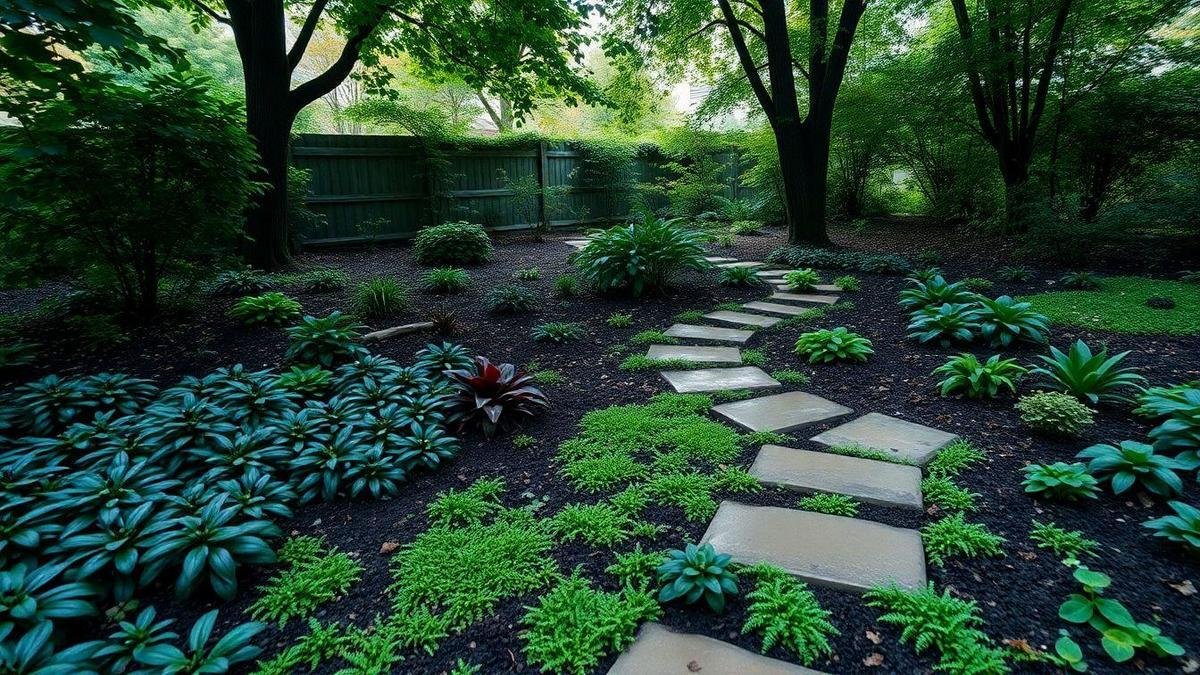
Groundcovers for shade I use to stop mud and fill space
I hate mud. Groundcovers stop it and finish the bed. I pick fast spreaders that tolerate low light and low fuss. For groundcover-focused shade gardens, see my notes on low-maintenance plantings.
Ajuga, pachysandra, and vinca minor — groundcovers that cover fast
Each has a purpose: Ajuga spreads fast and pops with color; Pachysandra is steady and tidy; Vinca minor creeps and flowers.
| Plant | Height | Spread/year | Light | Soil | Best traits | Watch out |
|---|---|---|---|---|---|---|
| Ajuga (bugleweed) | 3–6 in | 1–2 ft | Deep to dappled shade | Moist, well-drained | Fast cover, spring flowers, bold foliage | Can smother small natives |
| Pachysandra (Japanese spurge) | 6–12 in | ~1 ft | Deep shade | Rich, humusy, moist | Low maintenance, evergreen | Slow to fill; not for wet feet |
| Vinca minor (periwinkle) | 3–6 in | 2–3 ft | Shade to part sun | Tolerant, well-drained | Long runners, blue flowers, drought-tough | Can be invasive in mild zones |
I once planted ajuga to hide a muddy patch; it filled the spot in one season. Then I had to trim it—gardening karma.
Native groundcovers I like: wild ginger and sweet woodruff
For low-fuss, eco-friendly yards, I favor native groundcovers that support local insects—see more on sourcing and using native plants for local wildlife.
| Plant | Height | Spread | Light | Soil | Why I like it |
|---|---|---|---|---|---|
| Wild ginger (Asarum) | 4–6 in | Slow–steady | Deep shade | Rich, moist | Natural look; handles dry shade under oaks |
| Sweet woodruff (Galium) | 6–12 in | Moderate | Dappled shade | Moist, well-drained | Spring scent, pretty white flowers, tidy mats |
Both are excellent Shade Tolerant Plants for colorful landscaping under trees when you want calm, green carpets without fuss.
Spacing, planting depth, and coverage tips for groundcovers
- Spacing: plugs 6–12 in apart for fast cover; pachysandra 8–12 in; runners 12–18 in.
- Depth: plant level with the pot—don’t bury the crown.
- Watering: water well at planting, then daily for a week; afterward water deeply only when soil is dry—follow strategies in preventing over- and underwatering.
- Soil prep: add compost for poor soils; avoid overworking heavy clay—plant on a slight mound.
- Mulch: thin layer to suppress weeds; leave a small gap at stems.
- Coverage timeline: fast spreaders show mats in one season; slow fillers take 2–3 seasons.
| Plant | Spacing | Planting depth | Expected cover time |
|---|---|---|---|
| Ajuga | 6–12 in | Level with soil | 1 season |
| Pachysandra | 8–12 in | Level with soil | 2 seasons |
| Vinca minor | 12–18 in | Level with soil | 1–2 seasons |
| Wild ginger | 6–12 in | Level with soil | 2 seasons |
| Sweet woodruff | 8–12 in | Level with soil | 1–2 seasons |
Trim only to shape; let the groundcover do the heavy lifting.
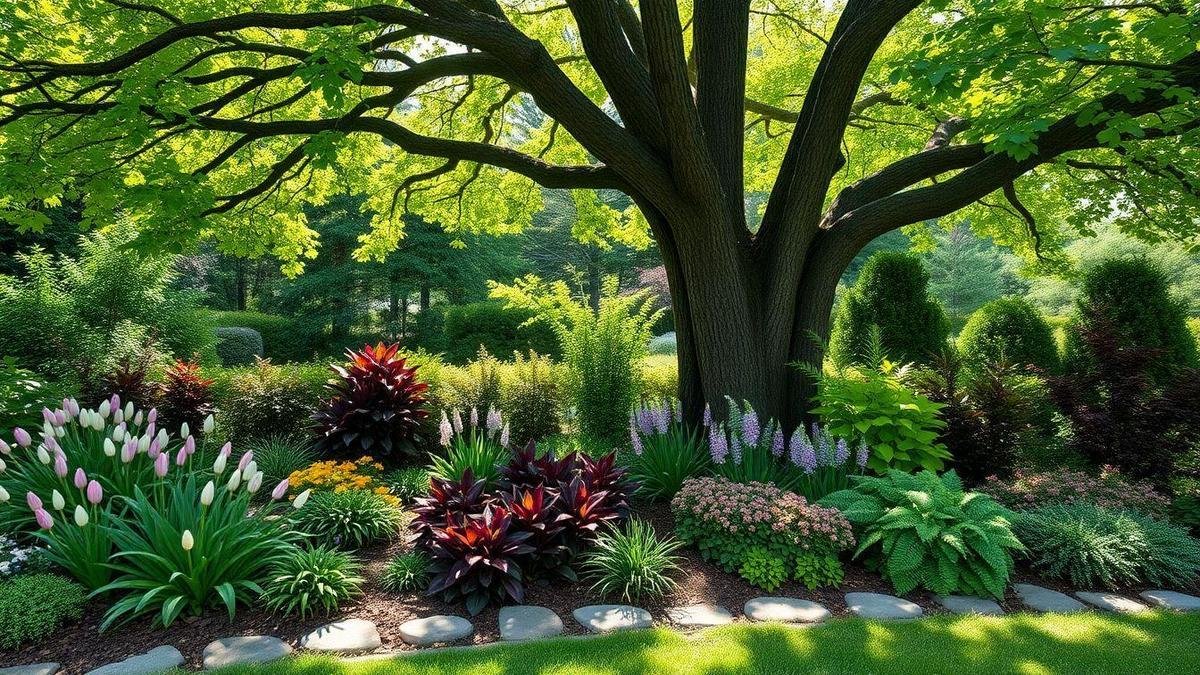
How I plan seasonal color under trees using Shade Tolerant Plants for colorful landscaping under trees
Spring bulbs and ephemerals I plant for early light
I tuck in early bulbs and ephemerals to catch the sunlight through bare branches.
Favorites: Crocus, Snowdrops (Galanthus), Grape hyacinth (Muscari), dwarf/species tulips, and woodland ephemerals like wood anemone, bloodroot, and trout lily. For timing and prep, see my checklist on preparing your garden for spring planting.
| Plant | Bloom Time | Light / Soil Notes |
|---|---|---|
| Crocus | Very early spring | Part shade, well-drained |
| Snowdrops | Late winter — early spring | Shade, moist soil |
| Muscari | Early spring | Part shade, tolerates heavier soil |
| Species tulips | Mid spring | Part shade, lift or naturalize |
| Wood anemone | Spring | Shade, spreads slowly |
Plant bulbs in fall. They reward you with bright patches while trees are still bare.
Summer and fall choices for late-season color
When bulbs fade, I rely on foliage stars and late bloomers.
Go-tos: Hosta, Heuchera, Astilbe, Japanese anemone, Tricyrtis (toad lily), Impatiens, Coleus.
| Plant | Peak Season | Why I use it |
|---|---|---|
| Hosta | Summer | Bold foliage fills gaps |
| Heuchera | Summer–Fall | Colorful leaves all season |
| Astilbe | Mid-summer | Airy blooms in shade |
| Japanese anemone | Late summer–fall | Long bloom time |
| Tricyrtis | Fall | Late, delicate flowers |
| Impatiens / Coleus | Summer | Fast color, great in containers |
Timing bulbs and perennials so one group hands off to the next
Simple plan:
- Fall: plant bulbs and mark spots.
- Early spring: enjoy bulbs; let foliage die back naturally.
- Late spring: perennials rise and hide bulb foliage.
- Summer–fall: perennials and late bloomers take over; add pots if needed.
I mark bulbs with small stakes—one year I stepped on a tulip bed and learned my lesson.

Low-maintenance shade plants I trust for lazy gardeners
I like plants that do the job and mind their own business—ferns, sedges (Carex), and easy hostas. They forgive my forgetfulness and give texture and color where grass can’t grow. For more low-effort options, see the best plants for a low-maintenance garden and the best perennial flowers for low-maintenance gardens.
| Plant | Light | Water | Why I pick it |
|---|---|---|---|
| Ferns | Deep to dappled shade | Steady, not soggy | Feathery look; bounce back after heat |
| Sedges (Carex) | Light to deep shade | Moderate | Tough, tidy clumps; handle dry spells |
| Easy Hostas | Dappled shade | Regular | Big leaves, forgiving of missed water |
Simple care routines and mulch tips to cut work in half
I keep three chores: water, mulch, check leaves.
- Deep water once a week in dry spells—deep beats frequent shallow drinks; learn technique in how to prevent over- and underwatering.
- Lay 2–3 inches of mulch to stop weeds. Less weeding = more coffee.
- Quick spring clean to remove dead leaves—no heroics.
| Task | Quick rule |
|---|---|
| Watering | Water until soil is moist 4–6 inches down; do it slowly. |
| Mulching | Keep mulch 2–3 inches; leave a gap at stems. |
| Soil | Add compost for clay or sandy soils; plants prefer loose, slightly rich soil. |
Check soil with a trowel: if it’s dusty, add compost; if it sticks together, it’s fine.
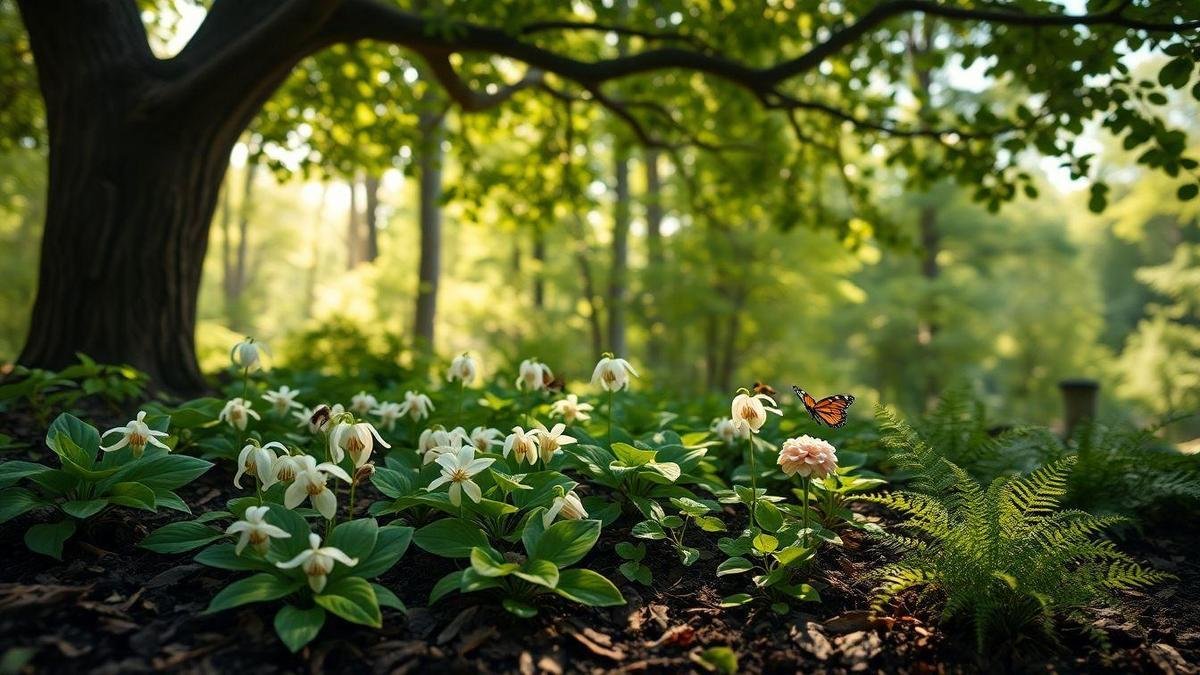
Native shade plants I choose to help pollinators and build soil
Why I prefer native shade plants
I pick native shade plants because local bees and butterflies recognize them. Natives often need less water and fewer chemicals, build stronger soil, and support a web of life under my trees. Use Shade Tolerant Plants for colorful landscaping under trees to wake up dull patches with low fuss and to help local wildlife—read more about using wildlife-friendly gardening practices.
Native flowering plants for under trees that I recommend
| Plant (common name) | Bloom time | Pollinators | Light & soil notes |
|---|---|---|---|
| Trillium | Early spring | Bees, native flies | Deep shade, rich soil |
| Virginia Bluebells | Spring | Bees, early butterflies | Moist, part shade |
| Bloodroot | Early spring | Bees | Rich, well-drained shade |
| Foamflower | Spring–early summer | Bees, small flies | Part to full shade, humusy soil |
| Wild Ginger | Spring | Ground bees, beetles | Deep shade, moist soil |
| Solomon’s Seal | Spring–early summer | Bees, bumblebees | Dappled shade, adaptable soil |
| Columbine | Spring | Hummingbirds, bees | Light shade, drains well |
| Mayapple | Late spring | Bees | Shade, spreads slowly by rhizome |
Plant a mix of early and late bloomers and group them in clumps so pollinators find them easily. For more on creating pollinator habitat, see my guide to building a butterfly- and pollinator-friendly garden.
Where to source native plants and how to check provenance
Look for sellers who can prove plants are local.
| Source | What I ask / check |
|---|---|
| Local native nurseries | Ask where the stock was grown and if they use local seed/seedlings |
| Native plant societies & swaps | Get plants grown by local gardeners; ask origin notes |
| Arboretums & botanical centers | Often sell region-true plants with good labels |
| Reputable online native growers | Ask for seed origin and nursery location |
Checklist before buying:
- Ask Was this grown locally or shipped in? If shipped, ask the region.
- Prefer species names over trade names or heavily bred cultivars.
- Look for county or eco-region on labels; big-box stores rarely list that.
- Call your state native plant society if unsure.
For more sourcing tips and regional specifics, consult resources on using native plants to support local wildlife.
Best combinations of Shade Tolerant Plants for colorful landscaping under trees
Some reliable combos I use:
- Shallow-moist area: Hellebores Pulmonaria Hostas — early interest and summer foliage.
- Damp pocket: Astilbe Hostas Ferns — texture and vertical spikes.
- Deep shade carpet: Wild ginger Foamflower Trillium — native, low, pollinator-friendly.
- Quick color ribbon: Ajuga Heuchera Vinca minor — fast cover with seasonal accents.
These combos balance bloom time, foliage contrast, and root behavior so the plants cooperate with tree roots. For overall garden design and layout ideas, pair these combinations with principles from how to design a beautiful home garden.
Conclusion
Work with the shade, not against it, and let color do the heavy lifting. I choose Hostas, Heuchera, and Astilbe for foliage and spikes, add quick-cover groundcovers to stop the mud, and favor native picks to feed pollinators and build healthy soil. Mulch, water deeply but infrequently, and plant bulbs so one group hands the baton to the next—seasonal color without sweat. It’s low-maintenance, high-impact gardening: a backyard party where the plants do the hosting and I take the credit. For more ideas and plant mischief, visit my full collection of posts.
Frequently Asked Questions
Q: What are easy shade tolerant plants to add color under trees?
A: Hostas, Heucheras, and Impatiens are easy winners. See more suggestions for low-light picks in the best plants for low-light gardens.
Q: How deep should I plant them near tree roots?
A: Keep planting shallow—set crowns at soil level and avoid heavy digging that disturbs tree roots. Follow gentle planting techniques in preparing beds and planting.
Q: How often do I water shade plants?
A: Water when the soil feels dry an inch or two down. In shade, less is usually more—deep, infrequent watering beats daily shallow sprays. See practical watering tips at how to prevent over- and underwatering.
Q: Will they fight my tree for food and water?
A: If you pick shallow-rooted, low-competing species, space them sensibly, and mulch, they generally coexist well. Trees usually win, but everyone benefits. For troubleshooting nutrition issues, check organic fertilizer and soil amendment guidance.
Q: Can I mix colors and textures for a fun look?
A: Absolutely. Pair bold leaves (like Hostas) with bright foliage (Heuchera) and a few flowering perennials for a balanced, party-like bed—not chaos. If light is a limiting factor, consider solutions in how to use reflective surfaces to increase light or explore alternative planting ideas for small or urban sites in small garden ideas.

